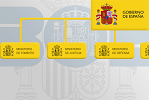Occupational risk prevention
Content
What is Occupational Risk Prevention?
- Prevention means the set of activities or measures adopted or foreseen for all the stages of a company’s work processes in order to avoid or decrease work-related risks.
- An occupational risk means the possibility that a worker could sustain a certain work-related injury.
- Diseases, pathologies or injuries sustained because of work or while working are considered work-related injuries.
Right to protection from occupational risks
The framework standard of reference is Law 31/1995 of 8 Novembere, on Occupational Risk Prevention (LPRL)![]() .
.
The LPRL expressly establishes the right of workers to effective occupational health and safety protection, which means that employers have a corresponding duty to protect their workers from occupational risks.
The rights of information, consultation and participation, training on prevention, cease of business activity in the event of a serious and imminent risk, and worker health monitoring are all part of workers’ rights to effective protection as regards occupational health and safety.
Principles of preventive action
Article 15 of the LPRL urges employers to apply measures that are part of the duty of prevention, in accordance with the following principles:
- Avoiding risks.
- Assessing risks that cannot be avoided.
- Combatting risks at their source.
- Adapting work to the individual.
- Taking into account technical advancements.
- Replacing the dangerous by the non-dangerous or the less dangerous.
- Developing a prevention policy.
- Giving collective protective measures priority over individual protective measures.
- Giving appropriate instructions to workers.
An employer will consider the professional skills of the workers when entrusting tasks to them.
Management of occupational risk prevention at a company
Occupational risk prevention must be integrated in the general management system of a company, both in its work as a whole and at all hierarchical levels of the company, by implementing and applying an occupational risk prevention plan.
This occupational risk prevention plan must include the organisational structure, responsibilities, functions, practices, procedures, processes and resources that are necessary for taking preventive actions at a company, under the terms set forth in the rules and regulations.
The essential instruments for applying a risk prevention plan are the occupational risk assessment and planning of the preventive activity.
What is a risk assessment?
Royal Decree 39/1997 of 17th January, by virtue of which the regulations for prevention services are approved, defines in it´s article 3 ![]() the risk assesment as an occupational risk assessment is a process designed to estimate the magnitude of risks that could not be avoided, thereby obtaining the necessary information so that an employer is able to make the appropriate decision about the need to adopt preventive measures and, in such a case, about the type of measures that must be adopted.
the risk assesment as an occupational risk assessment is a process designed to estimate the magnitude of risks that could not be avoided, thereby obtaining the necessary information so that an employer is able to make the appropriate decision about the need to adopt preventive measures and, in such a case, about the type of measures that must be adopted.
Further information
- More information on what to assess and how, when to conduct a risk assessment and who should conduct a risk assessment is available in the following document:: Basic guidelines for assessing occupational risks – 2021
 .
. - Basic guidelines for occupational risk prevention in the workplace
An employer’s responsibilities
Employers, including the Public Administrations, have the duty to protect their workers from occupational risks, ensuring their health and safety in all work-related aspects, by integrating preventive activities at their company and adopting all the necessary measures.
More information available in the Labour Guide of the Ministry of Labour and Social Economy and Ministry of Inclusion, Social Security and Migration.![]()
Organisation of resources for preventive activities
An employer will organise the necessary resources for developing preventive activities depending on the number of workers who are exposed and the magnitude and category of the risks, using any of the following arrangements:
- The employer may undertake preventive activities themselves ( Article 11 of Law 31/1995 of 8 November on the Prevention of Occupational Risks
 ).
). - One or more workers may be appointed to undertake these activities ( Articles 12 and 13 of Law 31/1995 of 8 November on the Prevention of Occupational Risks
 ).
). - An internal prevention service may be set up ( Articles 14 and 15 of Law 31/1995 of 8 November on the Prevention of Occupational Risks
 ).
). - A joint prevention service may be set up ( Article 21 of Law 31/1995 of 8 November on the Prevention of Occupational Risks
 ).
). - An external prevention service may be used ( Articles 16, 17 and 18 of Law 31/1995 of 8 November on the Prevention of Occupational Risks
 ).
).
Annex I of the Regulation on Prevention Services![]() sets forth the activities to be considered when organising prevention resources for processes that are hazardous or have special risks affected by specific provisions in some aspects of ORP (Occupational Risk Prevention), such as conducting the ER (Risk Assessment) or ensuring CAE (Coordination of Business Activities).
sets forth the activities to be considered when organising prevention resources for processes that are hazardous or have special risks affected by specific provisions in some aspects of ORP (Occupational Risk Prevention), such as conducting the ER (Risk Assessment) or ensuring CAE (Coordination of Business Activities).
Rights and obligations of workers
Rights of workers
- To be directly informed of the specific risks affecting their job or role and of the protective and preventive measures applicable to those risks, and any emergency measures.
- To receive sufficient and suitable theoretical and practical training.
- To interrupt their activity and, if necessary, leave the workplace due to a serious and imminent risk to their life or health.
- To periodic monitoring of their state of health according to the risks inherent in the job.
- To have specific preventive measures available.
- To be consulted and to participate in all matters that might affect occupational health and safety.
Obligations of workers
- To use machines, tools, dangerous substances, equipment and any work tool appropriately.
- To use the protective means and equipment provided by the employer correctly and according to the instructions given.
- Workers must not disable safety devices and must correctly use any safety devices that exist or that are installed on the equipment related to their work or in their workplaces.
- To report immediately any situation that, in the worker’s opinion, might involve a risk to worker health and safety.
- To contribute to compliance with the obligations established by the competent authority.
- To cooperate with the employer so that the employer can guarantee working conditions that are safe and do not put workers at health and safety risks.
Protection from labour risks for ‘specific groups’
The following sets of workers are considered to be specific groups:
- either they are covered by specific regulations on occupational risk prevention that regulate their health and safety;
- or they could be more vulnerable to occupational risks, and special attention must be paid to assessing the job they do and to taking the necessary measures to ensure their safety and protect their health.
These groups include the following:
- female workers who are pregnant or who have recently given birth;
- workers who, due to their personal characteristics or a known biological condition, including those who have a recognised physical, mental or sensory disability, are especially susceptible to work-related risks;
- young people under 18 years of age, due to their lack of experience, their immaturity for assessing potential or existing risks or due to their incomplete development.
An employer must ensure the protection of workers included in these groups, and to this end, the employer must conduct a risk assessment of the jobs done or likely to be done by these workers, considering their specific characteristics (pregnancy or recent childbirth, special sensitivity to certain risks, minor), and adopt the necessary preventive and protective measures. Law 31/1995 of 8 November on occupational risk prevention (LPRL) sets out these obligations in detail in Articles 25, 26 and 27 .
Management of occupational risks for self-employed workers and SMEs (small and medium enterprises)
Prevencion10.es![]() is a free public advisory service on occupational risk prevention targeted at:
is a free public advisory service on occupational risk prevention targeted at:
- self-employed workers and
- SMEs (small and medium enterprises).
Its purpose is to not only simplify the management of occupational risks for companies of up to 25 workers but also to facilitate compliance with the coordination of business activities and to inform self-employed workers about those risks.
Related agencies and departments
-
National Institute of Occupational Health and Safety
The National Institute of Occupational Health and Safety (INSST) is the specialised scientific-technical agency of the State General Administration whose mission is to analyse and study occupational health and safety conditions, as well as promote and support the improvement thereof. You can find all the available information about this agency on the INSST website
(INSST) is the specialised scientific-technical agency of the State General Administration whose mission is to analyse and study occupational health and safety conditions, as well as promote and support the improvement thereof. You can find all the available information about this agency on the INSST website .
.
Contact: The INSST places several communication channels at your disposal, whereby you can pose questions of interest in relation to the different services it offers, which are included in its Portfolio of Services.
The INSST places several communication channels at your disposal, whereby you can pose questions of interest in relation to the different services it offers, which are included in its Portfolio of Services.
-
Labour and Social Security Inspectorate
The Central Labour and Social Security Inspectorate is responsible for the function of ensuring and monitoring regulations on occupational risk prevention.
is responsible for the function of ensuring and monitoring regulations on occupational risk prevention.
All the information about this agency is available on the ITSS website .
.
-
Directorate-General of Labour. Ministry of Labour and Social Economy
National Institute of Occupational Health and Safety
The National Institute of Occupational Health and Safety![]() (INSST) is the specialised scientific-technical agency of the State General Administration whose mission is to analyse and study occupational health and safety conditions, as well as promote and support the improvement thereof. You can find all the available information about this agency on the INSST website
(INSST) is the specialised scientific-technical agency of the State General Administration whose mission is to analyse and study occupational health and safety conditions, as well as promote and support the improvement thereof. You can find all the available information about this agency on the INSST website![]() .
.
Contact:![]() The INSST places several communication channels at your disposal, whereby you can pose questions of interest in relation to the different services it offers, which are included in its Portfolio of Services.
The INSST places several communication channels at your disposal, whereby you can pose questions of interest in relation to the different services it offers, which are included in its Portfolio of Services.
Labour and Social Security Inspectorate
The Central Labour and Social Security Inspectorate![]() is responsible for the function of ensuring and monitoring regulations on occupational risk prevention.
is responsible for the function of ensuring and monitoring regulations on occupational risk prevention.
All the information about this agency is available on the ITSS website![]() .
.
Directorate-General of Labour. Ministry of Labour and Social Economy
Information for each Autonomous Community












Andalucía Aragón Asturias, Principado de Balears, Illes Canarias Cantabria Castilla y León Castilla-La Mancha Cataluña Ciudad de Ceuta Ciudad de Melilla Comunitat Valenciana Extremadura Galicia Madrid, Comunidad de Murcia, Región de Navarra, Comunidad Foral de País Vasco Rioja, La
Legal and/or technical references
-
Law 31/1995 of 8 November on Occupational Risk Prevention

-
Royal Decree 39/1997 of 17 January approving the Regulation on Prevention Services

-
Occupational Risk Prevention (ORP) regulations on the INSST website

-
Labour Guide of the Ministry of Labour and Social Economy and Ministry of Inclusion, Social Security and Migration

-
Prevencion10











